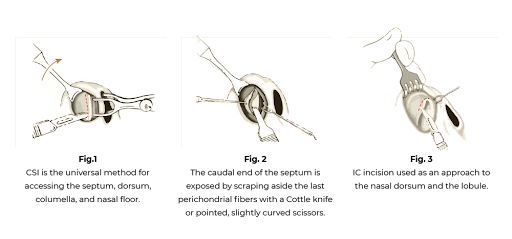Nasal Bridge Surgery
Dr. David Cangello is a board-certified plastic surgeon in New York City and is widely recognized as a leader in rhinoplasty and a pioneer of preservation rhinoplasty. Nasal bridge surgery is fundamental to rhinoplasty and Dr. Cangello is experienced in a range of techniques to successfully treat a variety of nasal bridge issues.
- Preservation Rhinoplasty for the Nasal Bridge
- Preservation Rhinoplasty Vs. Traditional Nasal Bridge Surgery
- Nasal Bridge Surgery to Narrow the Appearance of the Nose
- Nasal Bridge Surgery to Correct a Dorsal Bump
- Nasal Bridge Surgery to Correct a Saddle Nose Deformity
- Nasal Bridge Surgery to Improve Breathing Function
Preservation Rhinoplasty for the Nasal Bridge
Dr. Cangello is among an elite few surgeons to offer preservation rhinoplasty, and is one of the first rhinoplasty surgeons to offer this technique in the U.S. This modern approach to nose reshaping preserves as much of the original nasal structure as possible. Retaining the existing tissue, cartilage, and bone allows for a natural-looking result, improved nasal function, and a lower risk of complications. Preservation techniques lend themselves well to nasal bridge concerns, such as removal of humps, general bridge reshaping, and correction of minor asymmetries.
Preservation Rhinoplasty Vs. Traditional Nasal Bridge Surgery
Preservation rhinoplasty offers several key benefits over traditional nasal bridge surgical techniques. While preservation rhinoplasty is not appropriate for every patient, Dr. Cangello employs this approach for up to 80% of patients seeking nasal bridge surgery. The first, and possibly most significant, difference is that the dorsum is completely preserved—which means that there is no need to reconstruct the dorsum and cartilage grafts are not needed. Rather than shave down the dorsum, any bone and cartilage removal occurs underneath the nose bridge and subsequently the intact dorsum can be easily repositioned to lower the height of the nasal bridge. This eliminates the possibility of dorsum irregularities and can cut down on revision rhinoplasty procedures.
Another key difference is that the dissection takes place in a different plane than most traditional nasal bridge surgeries. In a preservation procedure, the perichondrium and the periosteum are left intact. These thin tissue layers are adherent to the cartilage and bone (respectively) that compose the nasal structure. All of the lymphatics and blood vessels that supply the soft tissues of the nose are above these very thin (one cellular layer thick) layers. By dissecting the nose below the perichondrial and periosteal layers, the veins, arteries and lymphatics are all preserved, thereby almost eliminating bruising and swelling and minimizing the duration of the latter. This reduces the patient’s social downtime. Dr. Cangello is among the first and one of just a handful of rhinoplasty surgeons in the United States who perform this dissection technique.
Finally, the tip plasty approach in a preservation procedure emphasizes a more natural look that allows us to avoid some of the problems with nose tip proportion that can be tell-tale signs of rhinoplasty.
Nasal Bridge Surgery to Narrow the Appearance of the Nose
It is important to take several factors into consideration when planning surgical treatment of an overly wide nose in which the nasal bridge will be narrowed. Essential elements to be taken into account when planning surgery to narrow the nasal bridge include:
- The width of the nasal base: A wide or flared alar base can give a bottom-heavy look to the nose—an effect that will be exaggerated if the nasal bridge is narrowed without bringing the nasal base into proportion. If the width of the nasal base extends beyond the inner canthus of each eye, a nasal base reduction should be incorporated into the surgical plan.
- Natural shape and desired aesthetic of the nasal tip: If the nasal tip is bulbous, broad, or drooping, it should be refined in a way that is in proportion to the new nasal bridge, as well as in line with the patient’s desired aesthetic.
- Proportions of the nose in relation to ethnicity and facial features: Calculations of “ideal proportions” are typically designed with caucasian features in mind. Additional considerations should be made for patients who are African-American, Persian, Middle Eastern, Asian, or otherwise non-caucasian and seeking ethnic rhinoplasty to preserve an appearance fitting with their heritage.
- Thickness and elasticity of the skin: Evaluation of skin thickness and condition goes hand-in-hand with ethnicity considerations, as patients with Hispanic or African-American heritage often have thicker nasal skin. The elasticity of the skin must be properly evaluated in the creation of the surgical plan and patient expectations must be managed because the nose cannot be narrowed beyond what the skin can accommodate.

Nasal Bridge Surgery to Correct a Dorsal Bump
In popular culture, the removal of a hump or bump on the bridge of the nose is the quintessential motivation for rhinoplasty—and to a layperson it may also seem like a simple or straightforward procedure. However, experienced and skilled rhinoplasty surgeons understand the complexity and nuance of technique necessary for a successful humpectomy. If care is not taken in a comprehensive rhinoplasty plan, the desired side profile result may be achieved but the harmony of the frontal appearance can suffer.
In order to ensure that a proportionate, natural-looking, and functional result is achieved, the rhinoplasty surgeon must plan to integrate a series of maneuvers beyond hump removal, including (but not limited to):
- Osteotomies may be performed in order to bring the width of the nose in proportion to the new bridge height.
- The integrity of the middle vault of the nose must be considered in order to determine if spreader grafts are necessary.
- The position and shape of the nose tip may need to be revised to harmonize with the slope of the nose.
Nasal Bridge Surgery to Correct a Saddle Nose Deformity
If the bridge of the nose is concave rather than straight or convex, it may be classified as a saddle nose deformity. Ranging from a mild imperfection to a severe deformity, saddle nose refers to a collapse of the nasal bridge and is so named for a saddle-like shape when looked at in profile. Saddle nose deformities are most commonly caused by a traumatic injury to the nose or a failed rhinoplasty.1 They are also associated with cocaine abuse, certain medical conditions, such as Hansen’s disease or granulomatosis with polyangiitis, or they may be congenital.
Careful assessment of the degree and cause of saddle nose deformity must be undertaken in order to develop an effective surgical plan. The actual nasal bone, as well as the dorsal septum and upper lateral cartilage may all show varying degrees of collapse. Additionally, the nasal tip may be shortened and have an upward rotation, as seen in what may be colloquially described as a “boxer” or “pug” nose.
Surgical correction of a saddle nose deformity will involve restoration or augmentation of the nasal bridge. In mild cases, a graft of septal cartilage may be sufficient to build appropriate height of the bridge. In more severe cases and those involving the nasal tip, more extensive grafting, such as costal cartilage grafting or a synthetic biocompatible grafting material, may be needed in order to build a strong bridge that will adequately support the reconstruction.
Nasal Bridge Surgery to Improve Breathing Function
For the successful rhinoplasty surgeon, form and function are synchronous. The primary objective of nasal bridge surgery may be aesthetic, but just as important is the preservation or improvement of breathing function. Many patients who undergo nasal bridge surgery will experience a passive improvement in nasal function due to the correction of underlying nasal obstruction. In many cases, a nasal bridge that is deviated is due to septal deviation, in which case septoplasty, which can improve nasal airflow, will be incorporated into the initial surgical plan.
References
1 Riechelmann H, Rettinger G. Three-Step Reconstruction of Complex Saddle Nose Deformities. Arch Otolaryngol Head Neck Surg. 2004;130(3):334–338. doi:10.1001/archotol.130.3.334
